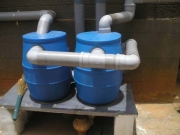/topics/climate-and-weather
Climate and Weather
Background on the Meteorological Datasets
Posted on 18 Sep, 2009 11:27 AMWe foresee that this data can be useful in making rainwater harvesting and water balance estimates, in various research areas, climate change adaptation studies and more. We also believe in the democratising effect of having this kind of data freely available to the general public.
How to create check dams for water conservation
Posted on 15 Sep, 2009 01:07 PMIn addition to controlling gully erosion, check dams also serve to slow the movement of water, allowing increased percolation into the soil. Just above a check dam is a good place to put in a percolation structure. Silt that builds up behind the dam creates good farmland, which can be planted after the rains while it retains moisture. The following series of pictures show one farmer’s success with building a percolation tank just upstream of a series of check-dams.
UNESCO training program on low flow, drought and climate change, April 2010, Thimphu
Posted on 08 Sep, 2009 04:31 AMForwarded to the Portal by: Preeti Gupta, WES-Net

Climate change campaigns undertaken by Greenpeace
Posted on 04 Sep, 2009 06:26 PMThe Greenpeace have undertaken a lot of commendable work in the field of climate change. This link takes you through their climate change campaigns involving the masses.
Water filters used in a rainwater harvesting system - A presentation by Arghyam
Posted on 04 Sep, 2009 10:38 AM This presentation by Arghyam deals with filters used in a rainwater harvesting system as also in other sources to remove suspended pollutants from rainwater collected. In a rainwater harvesting system, the water comes in contact with several surfaces, such as the roof or gutters. Water sources too are contaminated by various minerals and chemicals. These affect the colour, odour, taste and composition of water.Its flow becomes possibly mixed with leaves or dust.
This presentation by Arghyam deals with filters used in a rainwater harvesting system as also in other sources to remove suspended pollutants from rainwater collected. In a rainwater harvesting system, the water comes in contact with several surfaces, such as the roof or gutters. Water sources too are contaminated by various minerals and chemicals. These affect the colour, odour, taste and composition of water.Its flow becomes possibly mixed with leaves or dust.
Call for Papers - IWA 2010 World Water Congress and Exhibition
Posted on 03 Sep, 2009 04:57 PMForwarded to the Portal by: WinrockWater Yahoo Group Image and Content Courtesy: IWA Congress  The IWA World Water Congress & Exhibition is a high-profile international event attracting thousands of water professionals and organizations from across the globe. It is a biennial event organised by the International Water Association and previously hosted by Vienna, Beijing, Marrakech, Melbourne, Berlin and Paris. Montreal will be hosting the upcoming session from the 19th to 24th of September 2010. The IWA World Water Congress & Exhibition, the Associations main biennial event, is a valuable and unique opportunity for the community of world-leading water professionals to meet, exchange ideas, explore the state of the art and debate the key issues underlying the science and practice of water. It is also where the entire water community congregates and in particular IWA specialist groups showcase their work and plan for future activities.
The IWA World Water Congress & Exhibition is a high-profile international event attracting thousands of water professionals and organizations from across the globe. It is a biennial event organised by the International Water Association and previously hosted by Vienna, Beijing, Marrakech, Melbourne, Berlin and Paris. Montreal will be hosting the upcoming session from the 19th to 24th of September 2010. The IWA World Water Congress & Exhibition, the Associations main biennial event, is a valuable and unique opportunity for the community of world-leading water professionals to meet, exchange ideas, explore the state of the art and debate the key issues underlying the science and practice of water. It is also where the entire water community congregates and in particular IWA specialist groups showcase their work and plan for future activities.
India's experience with drought management: Changed perspectives and challenges
Posted on 29 Aug, 2009 02:43 PMThis document describes the drought situation in India over the years, the earlier perspective at drought management and the gradual change in perspective at managing droughts that evolved over the years.
The how, what, when of climate change: Background and basics
Posted on 29 Aug, 2009 02:09 PMClimate Change is a significant change in temperature, wind patterns and precipitation that occurs over a long period of time. Some of these changes occur in cycles over decades, hundreds, thousands and millions of years; some could be random occurrences.
Using water sustainably in agriculture: Increasing productivity and farm income
Posted on 29 Aug, 2009 01:29 PMAgriculture is a vital sector in India with about 60% of the population engaged in agricultural vocations and contributing to about 30% of the GDP. It consumes about 80% of water used in the country and 76% of the net irrigated area in the country is from ground water sources.
Government of India's national action plan on climate change (NAPCC)
Posted on 29 Aug, 2009 12:08 PMThis would lead to a drastic increase in GHG emissions. There is the need to make a choice for a low-carbon path, even if there is no mandated reduction in GHG emissions.





